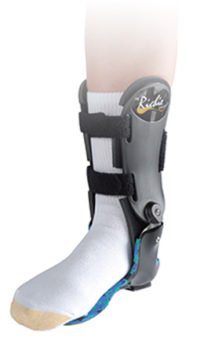The GOLD STANDARD of Custom Ankle-Foot Orthoses (AFO)
The Richie Brace® has restored mobility for thousands of patients for over 25 years, treating the most challenging foot & ankle conditions … become a part of the story.
The Richie Brace® is a revolutionary alternative to traditional ankle-foot orthoses (AFOs).

The Richie Brace® was designed and introduced to the medical community in 1996 by sports podiatrist, Dr. Doug Richie. Since that time the Richie Brace® has become the gold standard treatment in the orthotics industry. It is universally recognized by podiatrists, pedorthists, orthotists and orthopedic surgeons as a unique, breakthrough technology to treat a wide variety of foot and ankle conditions.
The lightweight construction and low profile design features of the Richie Brace allows better shoe fit, more freedom of movement and reduced pain from injury. Many of our patients can eventually recover and discontinue wearing their brace. That’s why our commitment to “Restoring Mobility” is on every product we make.
MOST COMMON CONDITIONS CURRENTLY TREATED:
- Posterior Tibial Tendon Dysfunction (PTTD) – also known as adult-acquired flat foot – is a painful flatfoot condition which affects adults, primarily over the age of 50.
- Dropfoot – is a condition where a person has difficulty lifting the front part of the foot. If you have foot drop, you will tend to drag your toes across the ground during walking. You may compensate for this problem by lifting your knee higher. In mild cases of foot drop, you will hear and feel your foot “slap” on the ground during walking
- Plantar Heel Pain – Pain on the bottom of the heel is most likely due to plantar fasciitis. This condition begins as an inflammation of the plantar fascia which is a strong ligament connecting the heel to the toes of the foot.
- Posterior Heel Pain – Pain on the back of the heel bone is usually caused by inflammation of the attachment of the Achilles tendon. Often times, a bursa sac of fluid forms here as well as a bone spur.
- Degenerative joint disease (DJD) is a form of arthritis. Patients with DJD suffer from pain due to inflammation in their joint cartilage. Many times, the cartilage can be worn down completely and then lost. The movement of the ankle becomes more weakened over time and mobility is difficult.
- Lateral ankle instability, also know as chronic ankle instability, is a condition which causes a patient’s ankle give out on the person, causing the outside of the ankle to bend down toward the ground, the same way ankles do when they are sprained. Lateral ankle instability is prevalent during activities such as running, walking, and sometimes even just standing. Lateral ankle instability is usually the result of multiple ankle sprains, or turning of the ankle. For this reason athletes are prone to have chronic lateral ankle instability. Every sprain weakens the ankle ligaments, causing the ankle to turn more often, however, due to the elasticity of the weakened tendons, a sprain does not occur.
- Patients with tendinopathy often experience tenderness and pain with movement of the injured tendon and/or the surrounding tendon area. The pain is sometimes experienced with touch only, and no movement. The pain may be acute or chronic. Acute pain is usually paired with inflammation of the tendon. Depending on the type of tendinopathy, immobilization is often necessary for healing.
EASE OF USE:
FIT AND COMFORT:
The Richie Brace® is lighter than most other AFOs. The leg uprights are designed to leave the front and back leg areas open for air flow and comfort. Once the Richie Brace® is positioned and adjusted, the patient is hardly aware he/she has it on.
APPLICATION AND REMOVAL:
After initial adjustment of the three straps, daily application and removal of the Richie Brace® involves the simple opening and closing of just one strap. All of the straps of the Richie Brace can be easily and in-expensively replaced without the need for rivots or glues.

